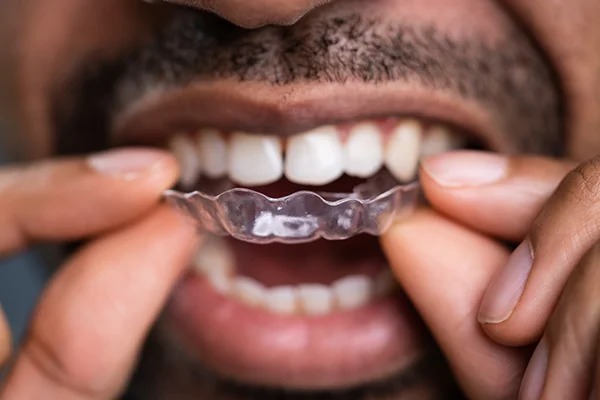Does Invisalign Hurt?
Posted on 12/12/2023 by Office at Avery Dental Center |
 In the dazzling world of perfect smiles, Invisalign has become the celebrity darling. Its clear, convenient aligners promise subtle tooth-shifting without the metal-mouth blues. But let’s be honest, nobody wants to suffer for a smile, so the question looms: “Does Invisalign hurt?” In the dazzling world of perfect smiles, Invisalign has become the celebrity darling. Its clear, convenient aligners promise subtle tooth-shifting without the metal-mouth blues. But let’s be honest, nobody wants to suffer for a smile, so the question looms: “Does Invisalign hurt?”
The answer, like most things in life, isn’t a simple yes or no. While Invisalign boasts less pain than its traditional braces, some discomfort is par for the course. Think of it as a little nudge from your teeth, saying, “Hey, we’re finally moving towards a better alignment!”
Why Does Invisalign Hurt?
Invisalign aligners exert pressure on teeth to gradually shift them into alignment, a process integral to their effectiveness. The discomfort experienced with Invisalign is akin to a mild squeezing sensation around the teeth. This sensation, while uncomfortable, signifies the aligners’ active engagement in realigning teeth. Additionally, friction from the edges of aligners against the gums and inner lips can contribute to discomfort.
Understanding the Duration of Discomfort
The duration of discomfort with Invisalign aligners varies from individual to individual. Generally, new sets of aligners may induce tooth pain lasting up to two weeks, with the intensity often peaking in the initial days of treatment. However, most patients find that the discomfort subsides within the first week as their teeth adjust to the aligners’ pressure.
Managing Invisalign Discomfort
Minimizing discomfort during Invisalign treatment is achievable through simple yet effective strategies:
Dental Wax
Applying dental wax along the rough edges of the aligners can mitigate gum pain caused by friction. The wax serves as a protective barrier, reducing irritation and discomfort.
Soft Foods Diet
During the initial days of wearing new aligners, sticking to soft foods can alleviate tooth sensitivity. Soft foods lessen the strain on teeth and gums, promoting comfort during the adjustment period.
Nighttime Aligner Wear
Wearing new sets of aligners before bedtime allows patients to sleep through the initial discomfort. Overnight wear minimizes the awareness of discomfort and facilitates smoother adjustment to the aligners.
Pain Relief Medication
For individuals experiencing significant discomfort, over-the-counter painkillers like ibuprofen or acetaminophen can provide relief. However, it’s advisable to consult a healthcare professional before taking any medication, especially for individuals with pre-existing medical conditions.
Considerations for Prospective Patients
Before embarking on an Invisalign journey, prospective patients should consider the following factors:
Treatment Expectations
Understanding the anticipated discomfort levels and duration can help patients mentally prepare for their Invisalign treatment journey.
Consultation with Orthodontist
Consulting with an experienced orthodontist allows patients to discuss their concerns and explore personalized pain management strategies tailored to their unique needs.
Lifestyle Adjustments
Patients may need to make temporary lifestyle adjustments, such as dietary modifications and aligner wear schedule changes, to optimize comfort during treatment.
Does Invisalign Hurt during Retention?
Retention is the crucial phase of maintaining the newly aligned position of your teeth post-treatment. It prevents them from shifting back to their original misaligned state, safeguarding the progress achieved. The simple answer is no; it doesn’t cause discomfort.
Retention methods typically involve using trays similar to those you wore during treatment, a fixed wire positioned behind your teeth, or a combination of both.
If you choose removable trays, you’re already familiar with them. In the case of a fixed wire, your tongue may experience slight irritation initially, but this discomfort usually subsides within a few days.
Conclusion
“So, Does Invisalign hurt?” While being highly effective, it may entail some degree of discomfort, particularly during the initial stages of wearing new aligners. However, compared to traditional metal braces, Invisalign aligners offer a relatively less painful orthodontic experience. By understanding the nature of discomfort and employing proactive pain management techniques, patients can navigate their Invisalign journey with greater comfort and confidence.
How We Can Help
If you’re experiencing any discomfort, such as facial swelling, bleeding gums, or intense pain when consuming food and drinking liquid, reach out to our team of skilled orthodontists at Avery Dental Center in Dublin, OH. Book your consultation online now, or new patients can call us directly at 614-683-9557. For existing patients, reach us at 614-789-9000. Don’t let discomfort disrupt your smile – we’re here to help you find relief and regain your oral health.
FAQs
Is Invisalign more comfortable than traditional braces?
While Invisalign aligners may cause initial discomfort, they are generally considered less painful than traditional metal braces due to their smooth, removable design.
How long does Invisalign hurt?
In most cases, discomfort from wearing new Invisalign aligners diminishes within the first week of treatment as teeth adjust to the aligners’ pressure.
Can I use dental wax to alleviate Invisalign discomfort?
Yes, applying dental wax along the edges of the aligners can help reduce gum irritation caused by friction, enhancing overall comfort during treatment.
Are there any dietary restrictions with Invisalign?
While there are no strict dietary restrictions with Invisalign, it’s advisable to consume soft foods during the initial days of wearing new aligners to minimize tooth sensitivity.
Can I take painkillers for Invisalign discomfort?
Painkillers like ibuprofen or acetaminophen can help remove significant discomfort associated with Invisalign treatment. However, it’s essential to consult a healthcare professional before taking any medication, especially if you have underlying health conditions. |
|